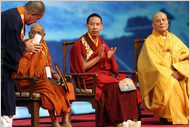China Names Its Own Lama to Top Body of Advisers
페이지 정보
작성자 관리자 작성일작성일 10-03-02 수정일수정일 70-01-01 조회7,339회관련링크
본문
BEIJING — China’s handpicked Panchen Lama, the teenage religious figure whose legitimacy is a matter of dispute among many Tibetan Buddhists, has been appointed to the country’s top advisory body, the state media have announced.
Although membership in the advisory group, the Chinese People’s Political Consultative Conference, is of nominal interest to Chinese, the appointment of the Panchen Lama, 19, on Sunday ratchets up the government’s efforts to elevate his stature among Tibetans. Because he was appointed by Communist Party authorities rather than by Buddhist leaders, many Tibetans reject his religious authority as the ranking leader after the Dalai Lama, who has lived in exile since 1959.
Born as Gyaltsen Norbu, he was anointed the 11th Panchen Lama in 1995, after the Dalai Lama identified a different child as the latest incarnation of the Panchen Lama. A few weeks later, that boy and his family vanished. The government has said that they are in “protective custody,” but their whereabouts have been a mystery for 15 years.
According to Xinhua, the official news agency, the official Panchen Lama, just shy of his 20th birthday, is the youngest person ever appointed to the conference, which convenes this week as part of the annual pageant that includes meetings of the National People’s Congress, the country’s main legislative forum.
The advising conference is made up of wealthy businessmen, sports celebrities and prominent members of China’s ethnic minorities. It is also cynically viewed as a reward for retired officials. Among the 13 new members appointed Sunday was Li Changjiang, the former head of China’s food safety administration, who was forced to resign over the scandal involving melamine-contaminated milk.
Bkra-lo, a Tibetan scholar at the state-run Chinese Academy of Social Sciences in Beijing, said there was nothing surprising about Gyaltsen Norbu’s appointment to the advisory conference.
“He has a lot of influence and popularity among the Tibetan people, so it makes sense,” he said. “Although he is very young, he is also very learned.”
Last month, the state media liberally featured his elevation as vice president of the government-run Buddhist Association of China. In an address, he swore to uphold the leadership of the Communist Party and promised to “adhere to socialism, safeguard national unification and strengthen ethnic unity.”
Despite its stated devotion to atheism, the Communist Party has struggled to offer a counterweight to the immense stature of the Dalai Lama, whom it views as a separatist eager to sunder Tibet from China. The Dalai Lama says his only interest is greater religious and cultural autonomy for Tibetans.
Tsewang Rigzin, president of the Tibetan Youth Congress, an exile group in India, said no amount of grooming would burnish Gyaltsen Norbu’s reputation among Tibetans.
“If you look at the Tibetan struggle for the last 60 years, neither torture nor financial incentives by the Chinese have been able to win the hearts of the people,” he said. “Tibetans will never accept him as the Panchen Lama.”
Zhang Jing contributed research.
<NewYork Times.com>,2010/03/01
Although membership in the advisory group, the Chinese People’s Political Consultative Conference, is of nominal interest to Chinese, the appointment of the Panchen Lama, 19, on Sunday ratchets up the government’s efforts to elevate his stature among Tibetans. Because he was appointed by Communist Party authorities rather than by Buddhist leaders, many Tibetans reject his religious authority as the ranking leader after the Dalai Lama, who has lived in exile since 1959.
Born as Gyaltsen Norbu, he was anointed the 11th Panchen Lama in 1995, after the Dalai Lama identified a different child as the latest incarnation of the Panchen Lama. A few weeks later, that boy and his family vanished. The government has said that they are in “protective custody,” but their whereabouts have been a mystery for 15 years.
According to Xinhua, the official news agency, the official Panchen Lama, just shy of his 20th birthday, is the youngest person ever appointed to the conference, which convenes this week as part of the annual pageant that includes meetings of the National People’s Congress, the country’s main legislative forum.
The advising conference is made up of wealthy businessmen, sports celebrities and prominent members of China’s ethnic minorities. It is also cynically viewed as a reward for retired officials. Among the 13 new members appointed Sunday was Li Changjiang, the former head of China’s food safety administration, who was forced to resign over the scandal involving melamine-contaminated milk.
Bkra-lo, a Tibetan scholar at the state-run Chinese Academy of Social Sciences in Beijing, said there was nothing surprising about Gyaltsen Norbu’s appointment to the advisory conference.
“He has a lot of influence and popularity among the Tibetan people, so it makes sense,” he said. “Although he is very young, he is also very learned.”
Last month, the state media liberally featured his elevation as vice president of the government-run Buddhist Association of China. In an address, he swore to uphold the leadership of the Communist Party and promised to “adhere to socialism, safeguard national unification and strengthen ethnic unity.”
Despite its stated devotion to atheism, the Communist Party has struggled to offer a counterweight to the immense stature of the Dalai Lama, whom it views as a separatist eager to sunder Tibet from China. The Dalai Lama says his only interest is greater religious and cultural autonomy for Tibetans.
Tsewang Rigzin, president of the Tibetan Youth Congress, an exile group in India, said no amount of grooming would burnish Gyaltsen Norbu’s reputation among Tibetans.
“If you look at the Tibetan struggle for the last 60 years, neither torture nor financial incentives by the Chinese have been able to win the hearts of the people,” he said. “Tibetans will never accept him as the Panchen Lama.”
Zhang Jing contributed research.
<NewYork Times.com>,2010/03/01








